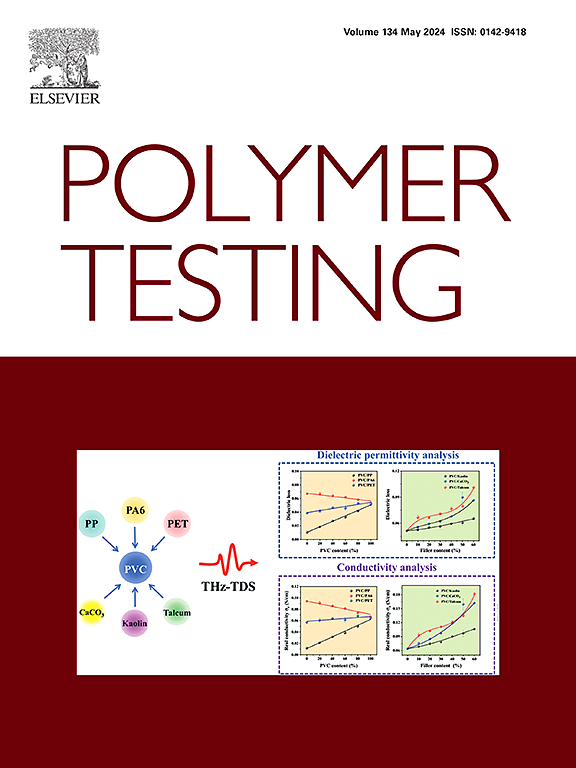Measurement and simulation of broadband radar absorption properties of polypyrrole nanotubes and their carbonaceous analogues
IF 5
2区 材料科学
Q1 MATERIALS SCIENCE, CHARACTERIZATION & TESTING
引用次数: 0
Abstract
The rapid development of unmanned aerial and ground vehicles (UAVs and UGVs, respectively) requires innovative means for their protection against detection and localization by radar microwave signals. Radar absorbing materials (RAMs) used in functional or structural composites of small, low-speed UAVs and UGVs can employ non-conventional fillers, such as nanostructured conductive polymers or their carbonaceous analogues. However, the work with non-conventional fillers brings difficulties in preparation and manipulation with sufficient amounts on a laboratory scale in a reasonable time and at a reasonable price. Therefore, computer simulation of filler behavior using software tools can be a vital solution to assess their ability to serve as RAMs. Here, polypyrrole nanotubes (PPy-NT) and carbonized polypyrrole nanotubes (PPy-C) were dispersed in polydimethylsiloxane matrix (PDMS) at low concentrations (1–3 % w/w) and their attenuation properties (reflection, absorption, and transmission coefficients), dielectric properties (complex permittivity and loss tangents) and apparent alternating current (AC) conductivity were evaluated between 2.6 GHz and 18 GHz. A 2 mm thin sample of the PPy-NT/PDMS composite at low concentration of 3 % w/w of the filler absorbs 28 % of the radar signal at 3.3 GHz. Using the simulation model made in CST Studio software, the evaluation of radar absorption properties was extended beyond the physical boundaries of the PPy-NT/PDMS sample, and the attenuation properties were evaluated up to a theoretical thickness of 100 mm (absorption of the signal 63 %). The presented method of simulation and the proposed model allows fast and flexible determination of attenuation properties of non-conventional RAMs of various thicknesses.
聚吡咯纳米管及其碳质类似物宽带雷达吸收特性的测量与模拟
无人机和地面车辆(分别为无人机和ugv)的快速发展需要创新的手段来保护它们免受雷达微波信号的检测和定位。用于小型低速无人机和ugv的功能或结构复合材料的雷达吸波材料(RAMs)可以使用非常规填料,例如纳米结构导电聚合物或其碳质类似物。然而,非常规填料的工作带来了在合理的时间和合理的价格下在实验室规模上制备和操作足够量的困难。因此,使用软件工具对填料行为进行计算机模拟是评估其作为ram的能力的重要解决方案。本研究将聚吡咯纳米管(py - nt)和碳化聚吡咯纳米管(py - c)以低浓度(1 - 3% w/w)分散在聚二甲基硅氧烷基体(PDMS)中,并在2.6 GHz至18 GHz范围内评估了它们的衰减特性(反射、吸收和透射系数)、介电特性(复介电常数和损耗切线)和视交流电导率。在填料浓度为3% w/w的情况下,2 mm薄的PPy-NT/PDMS复合材料样品在3.3 GHz时吸收了28%的雷达信号。利用CST Studio软件建立的仿真模型,将雷达吸收特性的评估扩展到py - nt /PDMS样品的物理边界之外,并对衰减特性进行了评估,直至理论厚度为100 mm(信号吸收63%)。所提出的仿真方法和模型可以快速灵活地确定不同厚度的非常规ram的衰减特性。
本文章由计算机程序翻译,如有差异,请以英文原文为准。
求助全文
约1分钟内获得全文
求助全文
来源期刊

Polymer Testing
工程技术-材料科学:表征与测试
CiteScore
10.70
自引率
5.90%
发文量
328
审稿时长
44 days
期刊介绍:
Polymer Testing focuses on the testing, analysis and characterization of polymer materials, including both synthetic and natural or biobased polymers. Novel testing methods and the testing of novel polymeric materials in bulk, solution and dispersion is covered. In addition, we welcome the submission of the testing of polymeric materials for a wide range of applications and industrial products as well as nanoscale characterization.
The scope includes but is not limited to the following main topics:
Novel testing methods and Chemical analysis
• mechanical, thermal, electrical, chemical, imaging, spectroscopy, scattering and rheology
Physical properties and behaviour of novel polymer systems
• nanoscale properties, morphology, transport properties
Degradation and recycling of polymeric materials when combined with novel testing or characterization methods
• degradation, biodegradation, ageing and fire retardancy
Modelling and Simulation work will be only considered when it is linked to new or previously published experimental results.
 求助内容:
求助内容: 应助结果提醒方式:
应助结果提醒方式:


